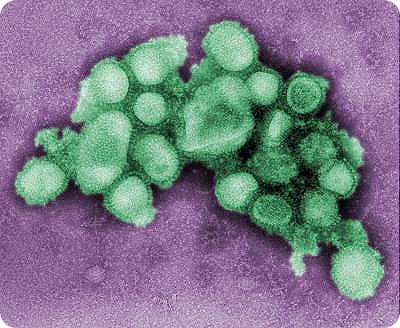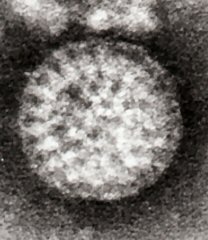We have come to the end of our blog. We hope that you have learnt much about what viruses are and how they reproduce. Thank you for viewing our blog.
Wednesday, 3 February 2010
Reverse Transcribing Viruses
Both types, DNA and RNA variants, involve the use of enzymes to integrate the viral genome into that of the host cell. In other words, these viruses are more or less of the latent type, where they will stay in you year upon year without causing any harm, then exploding out resulting in death.
One of the most important virus in this classification is the Hepatitis B virus, which is a DNA reverse transcribing virus. Transmission of the virus occurs via direct inoculation into blood, either by contaminated needles, blood transfusion or unprotected sex. It can also pass from the mother to unborn foetus via the placenta.
Hepatitis B virus infects the hepatocytes, or liver cells, causing inflammation, jaundice and even death. Latency in the cells can lead to liver cancer.
Liver cancer is one of the worse kinds of cancers to get, because the cancer itself is not very responsive to chemotherapy meaning that it is very hard to treat.
Tuesday, 2 February 2010
- Sense Single Stranded RNA Virus
Pandemic H1N1/09 Virus
The cause of the recent H1N1 pandemic is this virus. It is a random assortment of 5 different types of influenza viruses, one of which was a human influenza virus. Thus, this allowed the virus to spread amongst humans.
The virus itself is enveloped and enters the host cell via membrane fusion. Once within, positive hydrogen ions within the cytoplasm are channeled into the viral capsid where the pH change degrades the capsid protein, freeing the 8-segment negative sense RNA into the cytoplasm. There, RNA polymerases that were also released from the degradation of the capsid convert the negative sense into positive sense. After which, the RNA is transported via transporter protein to nearby ribosomes to be translated into proteins. After maturation, the new virions bud off the surface of the host cell, collecting their surface proteins and envelope at the same time.
The virulence of this virus is mild and its fatality rate is very low. All in all, not a very dangerous virus.
However, bearing in mind the use of RNA polymerase to convert the RNA leaves the genome highly susceptible to mutation, which is why scientists are monitoring the spread of the virus globally incase there is a mutation that causes the virus to become more virulent or more fatal.
Image of Pandemic H1N1/09

+ Sense Single Stranded RNA
Poliovirus
It is just as the name suggests, Poliovirus causes Polio. Polio is a highly virulent disease that leads to the damage or destruction of motor neurons. With their damage or destruction, paralysis will set in. In certain cases, the paralysis of certain skeletal muscles result in bone deformities that can lead to disability.
Poliovirus is a very simple virus, made up of only its capsid and RNA genome. Once it infects (Via fecal oral route) its victim however, the virus grows in the digestive tract and has a chance of entering the blood stream which can lead it to the brain or spinal cord, where it can spread to nerve cells.
In the body, the virus binds to special receptors on the target cells. This binding allows the virus to enter the host cell, where it uncoats and has its RNA immediately get translated by the host ribosomes. No conversion is needed due to the similarities between positive sense single stranded RNA and single stranded mRNA.
Due to the lack of cure for Polio, research began for a vaccine and and effort by the World Health Organisation (WHO) was started in 1988 to eradicate Polio. By 2006, Polio is only restricted to 4 countries, Nigeria, India, Pakistan and Afghanistan.
Image of Poliovirus
Double Stranded RNA Viruses
Rotavirus
This here, is not a very common virus. It is one of the causes of acute gastroenteritis, which is an inflammation of the stomach and/or small intestine. Gastroenteritis is usually not fatal, however in young children, the symptoms like diarrhea can be very severe.
This virus is transmitter via the fecal oral route and is not airborne. Therefore as long as the food you eat is clean and you are clean, you should not get infected by this virus.
Image of Rotavirus

Single Stranded DNA Viruses
Adeno-associated Virus
In this part of the blog, we will talk about the Adeno-associated Virus (AAV). This virus has its genome stored in single stranded DNA.
Now this virus is really small! Much smaller than your average virus. But what makes them really special is their inability to cause diseases upon infection!
Scientists have seen this potential and have exploited it to perform gene therapy. In these therapies, AAV are used as vectors to transport genes. However, the size of the gene is is limited by the relatively short length of the AAV genome. This means the large genes cannot be transported.
This virus infects a large variety of cells and have differing replication cycles depending on the type of cell.
Image of AAV

Double Stranded DNA Viruses
Varicella Zoster Virus
What we will be talking about in this post is the Varicella Zoster Virus (VZV), classified under herpesviridae meaning it is a type of herpes virus. It spreads via the air and close contact. This virus causes chicken pox in us and is usually a one time affair.
Why?
This is because the VZV is a DNA virus that transcribes its genome, from DNA to mRNA in the host cell nucleus. The presence of host cell DNA polymerase ensures that no mistakes will be made during transcription. This severely lowers the mutability of the virus meaning that once the body develops immunity against it (First chicken pox infection), new infection will not occur due to the ability of the immune system to recognise it easily and destroy it.
However, there is something else that is very important. During the first infection, when you are very sick, the symptoms are due to the lytic cycle of the VZV. At the same time however, certain cells are "reserved". In these cells, the VZV ONLY goes through the lysogenic cycle in them. These cells are the nerve cells.
Therefore after the initial infection you will never get chicken pox again however IF the virus resting within your nerve cells get activated, you will experience excruciating pain all over the body because nerve cells are spread all over.
Image of VZV

Monday, 1 February 2010
The Different Viruses!
Now that you know about how viruses reproduce, we will start talking about real viruses, how they infect and cause diseases in humans.

We will begin from group 1 all the way up to 7. With one type of virus for each.
Subscribe to:
Comments (Atom)

